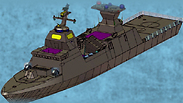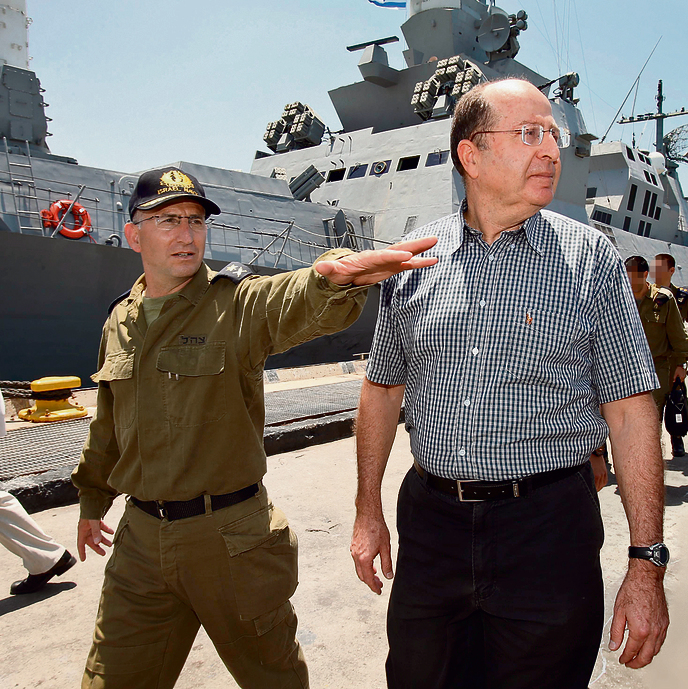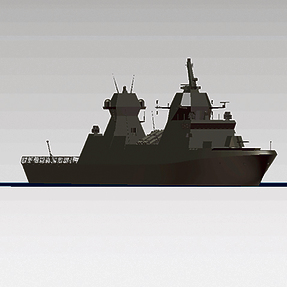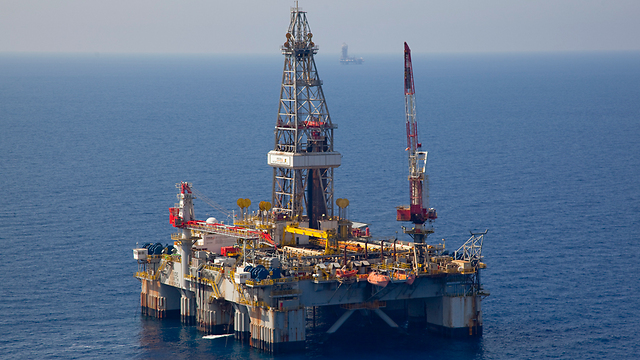
In deep water: The Defense Ministry’s sea of troubles
The submarine affair is just the tip of the iceberg: Dozens of police investigators are already sniffing around the Defense Ministry, determined to leave no stone unturned as they probe the decision-making process in the purchase of four Sa’ar 6-class corvettes that are scheduled to arrive in Israel in 2020, following a six-year delay.
When the Defense Ministry’s director-general received the list of the 10 police investigators appointed to handle the submarine and Sa'ar 6-class corvette affair, ministry officials raised an eyebrow at the size of the police team that is planning on leaving no stone unturned in their offices.
Defense Ministry workers and IDF officers are already being called for questioning. Department heads are required to open files and hand information over to the police investigators. The investigation tricks are underway too, creating even more embarrassment and confusion.
One of the first people to be questioned was the Defense Ministry’s legal adviser, attorney Ahaz Ben-Ari, who was likely asked about a conversation he had with attorney David Shimron some two years ago about the bid for the purchase of Sa'ar 6-class corvettes. The media quickly reported—perhaps too quickly—that attorney Ben-Ari backed attorney Shimron’s claim that Prime Minister Benjamin Netanyahu’s name was not mentioned in the conversation. But in the corridors of the Defense Ministry, there are those who are convinced that this is just an investigation trick aimed at distracting attorney Shimron, as there are those in the ministry who have heard entirely different things about the same conversation.
These are not the Defense Ministry’s finest days. Not only is it being presented as a marginal element in key security deals, which is disregarded by the prime minister and the National Security Council (NSC), but it has suddenly coming to light that the ministry’s security authority (the Director of Security of the Defense Establishment, or Malmab), which is in charge of keeping the State of Israel’s strategic secrets, did not know of and did not deal with the Iranian involvement in the German shipyard. And we may assume, according to foreign reports, that the submarines are part of the State of Israel’s strategic arm.
It turns out that two defense ministers and the last three director-generals of the Defense Ministry learned for the first time from Yedioth Ahronoth that there is a representative of an Iranian company sitting on the board of the German shipyard that was contracted to build the Navy’s submarines, and that that company is essentially a branch of the Iranian regime. A body like the Malmab should have known that Iran holds shares in the shipyard and treat this information as a warning bell. That, as we know, did not happen.
Former Defense Minister Moshe Ya’alon, who was surprised by the report, told his associates that he was unaware of any Iranian involvement in the German shipyard. Had he known about it, he said, he would have called for the appointment of a committee to look into the possible risks and take a series of measures to prevent the possibility of an information leakage. That is what the Defense Ministry did regarding the businesspeople and companies from Abu Dhabi that hold shares in the shipyards building the Sa'ar 6-class corvettes for the Navy.
The contact with the German shipyard was approved following an examination that was conducted at the time by the ministry’s chief security officer and the Malmab. But as opposed to Iran, Israel has extensive security trade relations with Abu Dhabi, according to Intelligence Online, and foreign reports say the two countries share a “special relationship.”
Then the Defense Ministry set another negative record. The ministry’s spokeswoman issued a statement claiming that the ministry had been aware of the Iranian involvement in the German ThyssenKrupp conglomerate and had taken the required measures. But two days before this dubious statement, the same spokeswoman—as well as the ministry’s high echelons—had no idea that Iran was involved in the company.

The ministry’s security personnel ran around the offices like chickens with their heads cut off, rummaging the archives in search of some kind of document to hold onto in order to save their professional dignity. Eventually, after leaving no stone unturned, someone recalled vaguely that there was some document that had been sent to the ministry 12 years ago.
The existence of this document was first reported by Yedioth Ahronoth. It turns out that an Israeli intelligence body, which monitors Iran’s economic-security relations in the world, noticed a report in the German press about a deal signed between an Iranian conglomerate and the ThyssenKrupp company and the appointment of an Iranian board member in the company. The report set off the required warning bell, and a document on the matter was sent to the Defense Ministry—both to the Malmab and to the ministry’s security officer.
What should the Defense Ministry have done with this information? It should have checked, for example, to what extent do the Iranians sitting on the company’s board have access to information regarding the submarine projects? Do the Iranians have the option of recruiting workers for the project? Are they able to influence the security of the shipyard and the port? In other words, those Iranian businesspeople should have been treated as nothing less than a branch of the Iranian intelligence.
Was that done? Absolutely not. If defense ministers and director-generals were unaware of the Iranian connection to ThyssenKrupp, it means that no one in the ministry handled the matter or did anything. So don’t let them tell you stories.
Defense Minister Avigdor Lieberman was dragged into his ministry workers’ cover-up attempts, perhaps wanting to protect them. Instead of putting them in their place, he explained that the Iranian affair has been discussed in the cabinet and in the NSC at some point. But his definition of the affair as “not so terrible” is the kind of statement that public figures live to regret, as Lieberman will find out very fast that he has not been told the whole truth.
A few years before he took office and a few years after the warning about the Iranian partnership in the shipyards was sent to the Defense Ministry, a number of troubling events took place, raising concerns of information leakages from the shipyards in Germany. Only last week, ThyssenKrupp announced that hackers had broken into the computers of the conglomerate’s engineering division, which also contain the plans related to the Israeli submarines. So “not so terrible” is not exactly the proper definition.
Securing exclusive economic zone
The submarine affair is just the tip of the iceberg pointing to the decision-making process in the field of defense purchases. A black stain, which is as problematic, is already spreading in the water, focusing on the decision-making process around the purchase of the Sa’ar 6-class corvette to protect the exclusive economic zone (EEZ).
The IDF’s affair with the protection of the EEZ (in other words, the search for gas in the Mediterranean Sea) began in 2004 with the need to protect the Yam Tethys drilling off the shores of Ashkelon. The army, at the time, was reluctant to get involved and was not even prepared to serve as a “professional guide” around the security of any civilian economic facility. But without security, the facility could not operate.

Maj.-Gen. (res.) Amos Yaron, the Defense Ministry director-general at the time, turned the Malmab into the professional guide of the EEZ protection in the Yam Tethys area. The security was performed by a private company, which employed graduates of the Navy’s commando unit.
Although the gas potential was already known, until 2010 the protection of the EEZ was perceived as an academic, latent issue. The Navy command completed extensive administrative work on the protection of the gas fields discovered off the shores of Israel only in 2011. The government defined the drilling areas as strategic sites—and not as a private business—making the defending of those sites a military mission for all intents and purposes. But more importantly, the army realized that this affair also included a lot of money that could free the General Staff from the Navy’s pressure to renew its surface combatants fleet.
The Sheshinski Report, issued in 2011, determined that half of the budget for defending the search and gas production areas would be received from the concessionaires and the other half would be come from the state budget. As far as the army was concerned, this was a bargain it could not refuse, which would secure the renewal of the Navy’s surface combatants fleet.
That year, everyone was busy making plans: The NSC, Defense Ministry Director-General Udi Shani, and the Navy were all busy shaping plans on how to defend the gas drillings ahead of the government's decision. One of the ideas they came up with was planting sensors in the sea to alert and scramble planes, helicopters and corvettes if a threat emerges. They eventually reached the conclusion that the physical presence of ships was the right solution. The defense outline they came up with determined that there must be a regular presence of at least two defense vessels in the search areas.
A calculation conducted by the Navy that year found that to implement this plan, the Navy needed four ships with a helipad and weapon and detection systems, such as anti-ballistic missiles, anti-ship missiles, anti-aircraft missiles, etc. These four heavy ships would be joined by three lighter Dvora-class fast patrol boats. To this package, they added Shoval UAVs that would hover above the ships and a particularly improved command post that would sit in Haifa and be in charge of the entire EEZ defense area.
This was the plan that was eventually presented to the government. The cost of the package was more than NIS 3 billion (about $780 million) over six years, till 2017.
In 2011, the Treasury was supposed to infuse NIS 68 million to the Navy so it could start building the EEZ security force. But the Navy didn't see a penny of that at the time, even though the Israeli government decided on January 23 that the allotments for the security would be made in accordance with the IDF’s instructions and would be separate from the defense budget. So what happened?
The lost year
The plan was that in 2014, the Navy would already have four patrol ships carrying long-range detection and defense systems, which would be called Sa’ar 6. But in practice, the State of Israel will only receive the first ship to protect its EEZ in 2020, at a six-year delay. Behind this delay is an odd and embarrassing story under the headline: This is how the State of Israel buys weapon systems.
What began as a modest demand to purchase a ship similar to the missile boats operated by the Navy at the time—which weigh 900 to 1,100 tons—ended with the purchase of the German “corvette”—which weighs almost double: 1,700 tons. The corvette, which was introduced into the German fleet about 10 years ago, underwent a proper conversion with Israeli weapon and electronic systems installed on it and was given the name “Sa'ar 6,” although it is clearly not a continuation of the advanced Sa’ar 5 missile boat.
Not a penny was received, but the administrative work continued, and ahead of 2013 it was already clear that the level of threats from the Syrian, Lebanese and Gazan shores required a larger vessel, which would also be able to carry the modern Adir radar—the newest fad in the field of detection, which allows the transfer of data for Air Force activity as well. The ship’s helipad had to be bigger as well to be able to carry the Seahawk helicopter (the naval Black Hawk), which is bigger than the helicopters placed on the missile boats today. Not to mention the fact that the rockets fired at Yam Tethys from Gaza during Operation Cast Lead motivated the Rafael factory to build a naval model of the Iron Dome defense system, which requires a larger boat.
And so a categorical decision was made in the Defense Ministry—starting from Defense Minister Moshe Ya’alon, through Director-General Udi Shani, to the head of procurement, Shmuel Tzuker, who was in charge of the implementation—to issue an international bid. Israel was not interested in purchasing a strategic weapon—only the body of a ship, free of equipment.
Germany, Italy, South Korea, the United Kingdom, the United States and India participated in the international bid. The Defense Ministry had a special interest at the time to compensate the Korean government after it had lost the bid for Air Force trainer planes to Italy and accused Israel of running an unfair bid. There are three shipyards in Korea, each with a separate agent in Israel—one of them is former Navy chief Eli Marom—and they work in competition to each other. The American Lockheed Martin company offered Israel boats that would be funded from the American foreign aid money. The Germans talked about a grant. Israel issued an initial engagement letter for the shipyards. At the same time, the Israel Shipyards also asked to participate in the boats’ production to maintain their abilities. The Navy rejected their request for its own reasons.
In early 2013, the Defense Ministry, together with the NSC—headed by Maj. Gen. (res.) Yaakov Amidror at the time—was about to submit the full proposal for the EEZ protection to the government’s approval, including a price tag. But then, a typical Israeli event happened: The government changed and all the old commitments were erased, as if they never happened. The bid had not been completed yet and the project was frozen after two and a half years of work.
The year 2013 was a lost year. Yesh Atid leader Yair Lapid entered the Finance Ministry, while the Defense Ministry had no budget, the army received a monthly financial allocation, and the boats issue was nowhere to be found in the work plan.
In 2014, some absurd discussions were held in Lapid’s office in 2014. In one of them, a Finance Ministry economist in charge of the defense budget said to then-Navy chief Maj. Gen. Ram Rothberg: “You should settle for three boats rather than four.” Rothberg was shocked. With this superficial statement, a government bureaucrat was making it clear to him—in Lapid’s presence—that in her professional opinion, Israel’s exclusive economic zone could be protected with three boats, dismissing the administrative work he had conducted for two and a half years.
The EEZ protection circus continued in the cabinet, as if nothing had ever been decided. In a ministerial committee meeting, the Defense Ministry and Navy were asked to reexamine the entire EEZ security process. Minister Yuval Steinitz demanded that the army look into the possibility of allowing private companies to protect the drilling areas, as the Russians were doing. It’s called “outsourcing.” They explained to him that the Navy was just the tip of the military intelligence system that ensures the security of the drillings, and that this system would not cooperate with private security companies. And so, the issue was dragged out throughout 2013, with no purpose whatsoever. The bids progressed in slow motion.
Throughout 2014, in informal conversations with Prime Minister Netanyahu, Defense Minister Ya’alon was told that it would be better to call off the bids and strike a deal with the Germans. At the time, Ya’alon did not attach any importance to those comments, but they already made him feel uncomfortable, because at the same time rumors began circulating about the involvement of interested parties—backed by the Prime Minister’s Office—in the purchase of the sixth submarine.
Meanwhile, five of the six countries whose shipyards matched the Navy’s requirements provided initial responses to the RFI (request for information) document distributed by the Defense Ministry. For some reason, this information was presented to the Germans, who announced that they would be willing to give Israel a 120-million-euro grant, so long as the boats are built in their shipyards.
In late 2014, there were discussions on the development of the Leviathan gas field, and the army began feeling the political system’s pressure to start moving fast in order to finalize things. In October, Defense Ministry Director-General Dan Harel convened the relevant parties at the ministry and informed them that the international bid for the boats’ purchase was being suspended until January 2015, and that the ministry would look into the German proposal. Shmuel Tzuker, the head of procurement, tried to insist on the obligation to carry out the bid, warning that the international companies that participated in it could file huge lawsuits against the Defense Ministry. That didn’t help. In January 2015, senior Israeli officials visited Germany, and a decision was made to purchase the vessels from the German shipyards.
The Navy will be doubled
This is where the Israel Police come in. What happened in the last months of 2014? What part did Avriel Bar-Yosef, deputy head of the NSC, who has been questioned on suspicion of taking bribes, play in the bid’s cancellation? Did Bar-Yosef pressure Tzuker to call off the bid and favor the Germans? What was behind attorney Shimron’s activity vis-à-vis the Defense Ministry’s legal advisor, Ahaz Ben-Ari? How did Bar-Yosef and Shimron’s pressure affect the cancellation of the international bid, and was the prime minister aware of the pressure or involved in it? Why are the Prime Minister’s Office and the NSC even involved in the negotiations for the purchase of conventional vessels? After all, this is not a case of strategic weapons. And why did the Defense Ministry give up its independence in the purchase of a military system?
If the police does have any information raising suspicions of inappropriate conduct or involvement of the Prime Minister’s Office in the decision to purchase the boats, it relates to this period.
The Navy, as the professional arm that was supposed to provide the operational solution for the security of the gas fields, was satisfied with the decision to purchase the boats in Germany. It already has an organizational body in Germany and is used to working with the Germans in vessel purchases.
The contract with the German shipyards was signed in August 2015. On the same month, 10 Navy officers led by Col. Yoram arrived in the city of Kiel with their families to manage the project of turning the K130 corvette into an Israeli defense boat.
From this point, it all went like clockwork. Currently, they are in the middle of planning how to match the boat’s body to the advanced Israeli systems, which will be installed on it once it arrives in Israel. The boat will sail to Israel completely free of equipment, apart from a naval radar and basic arms. When it docks in Israel, several different technologies and weapons will be waiting for it on the shore.
Dozens of Israeli companies, among the biggest and leading companies in the field of weapons, are taking part in the project and will turn the Sa’ar 6 into an advanced ship that will be capable of serving the Navy in offensive operations as well. “We have a very good combination here of the excellent and proven German engineering ability and the technological ability of the Israeli defense industry,” says Col. Yoram, the project manager in Germany.
The German shipyards will only begin building the vessels in 2018. The Germans will set up four simultaneous production lines in order to complete the construction of the four boats within 18 to 24 months. The boats will be delivered to Israel in late 2019 or early 2020, with a boat arriving every four months. All four are slated to become operational during 2021—a record time as far as the Navy is concerned. Thanks to the German subsidization, the ship’s price is about half the price of the Sa’ar 5 missile boat.
Upon the vessels’ arrival, the Navy’s battleship fleet will be tripled, totaling 15 warships: Corvettes and missile boats. They will be joined by three additional Dvora-class coastal patrol boats made in Israel. Add that to a fleet of six submarines and the expanded naval commando unit, and in the coming decade the Navy will simply double itself in size. By the way, the junior officers who will serve on the four new Sa’ar 6-class corvettes have already been selected. When they complete the sailors’ course they are currently undergoing, they will be sent to Germany to receive the boats.











